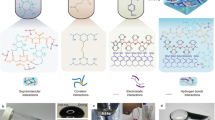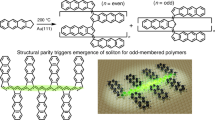Abstract
Soft polymers programmed with functional particles can be used to create intrinsically stretchable electronics. However, current approaches to fabricating such materials require that the particles be first colloidally dispersed in a liquid monomer or polymer solution that have limited material compatibilities and necessitate precise control over the associated fluid mechanics during the printing process. Here we report the direct incorporation of functional particles in soft polymers using particle engulfment, a process in which particles are spontaneously subsumed by the polymer matrix via surface energy. The engulfment phenomenon occurs when the characteristic size of the particles is much smaller than the elastocapillary length of the polymer matrix, resulting in an energetically stable configuration where functional particles become deeply embedded into the polymer. We use the approach to fabricate multilayered, multimaterial and elastic devices with wireless sensing, communication and power transfer capabilities.
This is a preview of subscription content, access via your institution
Access options
Access Nature and 54 other Nature Portfolio journals
Get Nature+, our best-value online-access subscription
$32.99 / 30 days
cancel any time
Subscribe to this journal
Receive 12 digital issues and online access to articles
$119.00 per year
only $9.92 per issue
Buy this article
- Purchase on SpringerLink
- Instant access to full article PDF
Prices may be subject to local taxes which are calculated during checkout




Similar content being viewed by others
Data availability
The data that support the findings of this study are available from the corresponding authors upon reasonable request. Source data are provided with this paper.
References
Ray, T. R. et al. Bio-integrated wearable systems: a comprehensive review. Chem. Rev. 119, 5461–5533 (2019).
Liu, S., Rao, Y., Jang, H., Tan, P. & Lu, N. Strategies for body-conformable electronics. Matter 5, 1104–1136 (2022).
Cho, K. W. et al. Soft bioelectronics based on nanomaterials. Chem. Rev. 122, 5068–5143 (2021).
Yuk, H., Wu, J. & Zhao, X. Hydrogel interfaces for merging humans and machines. Nat. Rev. Mater. 7, 935–952 (2022).
Rogers, J. A., Someya, T. & Huang, Y. Materials and mechanics for stretchable electronics. Science 327, 1603–1607 (2010).
Huang, Z. et al. Three-dimensional integrated stretchable electronics. Nat. Electron. 1, 473–480 (2018).
Rao, Z. et al. Curvy, shape-adaptive imagers based on printed optoelectronic pixels with a kirigami design. Nat. Electron. 4, 513–521 (2021).
Liu, Y. et al. Soft and elastic hydrogel-based microelectronics for localized low-voltage neuromodulation. Nat. Biomed. Eng. 3, 58–68 (2019).
Zheng, Y.-Q. et al. Monolithic optical microlithography of high-density elastic circuits. Science 373, 88–94 (2021).
Jiang, Y. et al. Topological supramolecular network enabled high-conductivity, stretchable organic bioelectronics. Science 375, 1411–1417 (2022).
Ohm, Y. et al. An electrically conductive silver–polyacrylamide–alginate hydrogel composite for soft electronics. Nat. Electron. 4, 185–192 (2021).
Tringides, C. M. et al. Viscoelastic surface electrode arrays to interface with viscoelastic tissues. Nat. Nanotechnol. 16, 1019–1029 (2021).
Hui, Y. et al. Three-dimensional printing of soft hydrogel electronics. Nat. Electron. 5, 893–903 (2022).
Xu, P. et al. Conductive and elastic bottlebrush elastomers for ultrasoft electronics. Nat. Commun. 14, 623 (2023).
Zhao, Y. et al. A self-healing electrically conductive organogel composite. Nat. Electron. 6, 206–215 (2023).
Kuang, M., Wang, L. & Song, Y. Controllable printing droplets for high-resolution patterns. Adv. Mater. 26, 6950–6958 (2014).
Hu, G. et al. Functional inks and printing of two-dimensional materials. Chem. Soc. Rev. 47, 3265–3300 (2018).
Zhang, C. J. et al. Additive-free MXene inks and direct printing of micro-supercapacitors. Nat. Commun. 10, 1795 (2019).
Huang, Q. & Zhu, Y. Printing conductive nanomaterials for flexible and stretchable electronics: a review of materials, processes, and applications. Adv. Mater. Technolog. 4, 1800546 (2019).
Zavanelli, N. & Yeo, W.-H. Advances in screen printing of conductive nanomaterials for stretchable electronics. ACS Omega 6, 9344–9351 (2021).
Wong, C.-H. & Zimmerman, S. C. Orthogonality in organic, polymer, and supramolecular chemistry: from Merrifield to click chemistry. Chem. Commun. 49, 1679–1695 (2012).
Khan, Y. et al. A new frontier of printed electronics: flexible hybrid electronics. Adv. Mater. 32, 1905279 (2019).
Gaikwad, A. M. et al. Identifying orthogonal solvents for solution processed organic transistors. Org. Electron 30, 18–29 (2016).
Lee, J. N., Park, C. & Whitesides, G. M. Solvent compatibility of poly(dimethylsiloxane)-based microfluidic devices. Anal. Chem. 75, 6544–6554 (2003).
Kim, S. Y. et al. Sustainable manufacturing of sensors onto soft systems using self-coagulating conductive Pickering emulsions. Sci. Robot. 5, eaay3604 (2020).
Tao, Y., Yeckel, A. & Derby, J. J. Steady-state and dynamic models for particle engulfment during solidification. J. Comput. Phys. 315, 238–263 (2016).
Liu, S., Pandey, A., Duvigneau, J., Vancso, J. & Snoeijer, J. H. Size-dependent submerging of nanoparticles in polymer melts: effect of line tension. Macromolecules 51, 2411–2417 (2018).
Style, R. W., Hyland, C., Boltyanskiy, R., Wettlaufer, J. S. & Dufresne, E. R. Surface tension and contact with soft elastic solids. Nat. Commun. 4, 2728 (2013).
Style, R. W., Jagota, A., Hui, C. Y. & Dufresne, E. R. Elastocapillarity: surface tension and the mechanics of soft solids. Ann. Rev. Condens. Matter Phys. 8, 99–118 (2016).
Johnson, K. L., Kendall, K. & Roberts, A. D. Surface energy and the contact of elastic solids. Proc. R. Soc. A: Math. Phys. Eng. Sci. 324, 301–313 (1971).
Cox, T. R. & Erler, J. T. Remodeling and homeostasis of the extracellular matrix: implications for fibrotic diseases and cancer. Dis. Model. Mech. 4, 165–178 (2011).
Shamsipur, M., Beigi, A. A. M., Teymouri, M., Pourmortazavi, S. M. & Irandoust, M. Physical and electrochemical properties of ionic liquids 1-ethyl-3-methylimidazolium tetrafluoroborate, 1-butyl-3-methylimidazolium trifluoromethanesulfonate and 1-butyl-1-methylpyrrolidinium bis (trifluoromethylsulfonyl) imide. J. Mol. Liquids 157, 43–50 (2010).
Style, R. W. et al. Universal deformation of soft substrates near a contact line and the direct measurement of solid surface stresses. Phys. Rev. Lett. 110, 066103 (2013).
Park, S. J. et al. Visualization of asymmetric wetting ridges on soft solids with x-ray microscopy. Nat. Commun. 5, 4369 (2014).
Lin, R. et al. Wireless battery-free body sensor networks using near-field-enabled clothing. Nat. Commun. 11, 444 (2020).
Kalidasan, V. et al. Wirelessly operated bioelectronic sutures for the monitoring of deep surgical wounds. Nat. Biomed. Eng. 5, 1217–1227 (2021).
Acknowledgements
R.L. acknowledges support from the South China University of Technology start-up funding and Xiaomi Young Talents Program. Y.L.K. acknowledges support from the National Institutes of Health (NIH) NIBIB Trailblazer Award (grant no. R21-EB029563), NIH R01 Award (grant no. R01-EB032959), Office of Naval Research Young Investigator Program Award (grant no. N00014-23-1-2391) and CDMRP Discovery Award (grant no. HT9425-23-1-0041). J.S.H. acknowledges support from the National Research Foundation (grant no. NRFF2017-07) and Ministry of Education (grant nos. MOE2016-T2-2-016 and MOE2016-T3-1-004).
Author information
Authors and Affiliations
Contributions
R.L., Y.L.K. and J.S.H. conceived and planned the research. R.L. and C.J. performed the experiments and data analysis. S.A. and X.Y. supported design of wireless devices. H.P.A.A. supported mechanical characterization of soft materials. R.L., Y.L.K. and J.S.H. wrote the paper with input from all the authors. All other authors contributed to discussing the data and commenting on the final manuscript.
Corresponding authors
Ethics declarations
Competing interests
The authors declare no competing interests.
Peer review
Peer review information
Nature Electronics thanks Kenjiro Fukuda and the other, anonymous, reviewer(s) for their contribution to the peer review of this work.
Additional information
Publisher’s note Springer Nature remains neutral with regard to jurisdictional claims in published maps and institutional affiliations.
Supplementary information
Supplementary Information
Supplementary Table 1, Figs. 1–22 and Video Captions 1–6.
Supplementary Video 1
Fabrication processes of particle engulfment and adhesion.
Supplementary Video 2
Electrical resistance of engulfment and adhesion samples.
Supplementary Video 3
Robustness of engulfment and adhesion samples against tape peeling.
Supplementary Video 4
Robustness of engulfment and adhesion samples against washing.
Supplementary Video 5
Motion sensing via an NFC sensor node.
Supplementary Video 6
Motion sensing via a radio-frequency tag.
Source data
Source Data Figs. 2–4
Source data for Figs. 2b–f, 3g–i and 4c,f,i.
Rights and permissions
Springer Nature or its licensor (e.g. a society or other partner) holds exclusive rights to this article under a publishing agreement with the author(s) or other rightsholder(s); author self-archiving of the accepted manuscript version of this article is solely governed by the terms of such publishing agreement and applicable law.
About this article
Cite this article
Lin, R., Jiang, C., Achavananthadith, S. et al. Soft electronics based on particle engulfment printing. Nat Electron 8, 127–134 (2025). https://doi.org/10.1038/s41928-024-01291-0
Received:
Accepted:
Published:
Issue date:
DOI: https://doi.org/10.1038/s41928-024-01291-0



